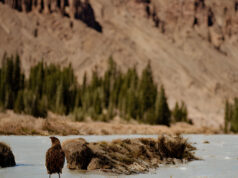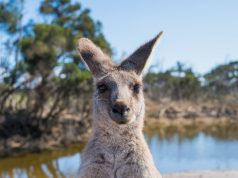When we think of birds we usually picture some small peaceful creatures, who symbolize peace and freedom. However, that’s not always the case. Birds can be some of the most fascinating creatures in the world to learn about. From their unique physical appearance to their creative traits and ways of living, birds are definitely a popular species. But some of them are prone to danger and could seriously harm you if you ever got too close.
Not to mention birds carry disease. So it’s not wise to try to pick up one or to even have them as a pet. They can pose as a potential danger to you and others. Although they are beautiful to look at, they are not safe to be around for long periods of time. Some birds are extremely scary.
They can even cause death. So here’s a list of 5 of the Most Dangerous Birds in the World.
 Image Source: Haydensanimalfacts.com
Image Source: Haydensanimalfacts.com#1. Southern Cassowary
The Southern Cassowary is a large flightless bird. It is a ratite and therefore related to emu, ostrich, and the Rhea and Kiwi genera. Cassowaries are closely related to the kiwis. Both families ended up diverging from a common ancestor approximately 40 million years ago. This is the most dangerous bird that inhabits the rain forests in New Guinea and northestern Australia. It prefers elevations below 1,100 m (3,600 ft) in Australia and 500 m (1,600 ft) in New Guinea. They have blue skin patches and black feathers.They weigh more than 130 pounds and are about 6 feet tall.
They are highly protective about their territory. They have razor sharp spurs and have the strongest kick forces among other animals. In 2007, this bird was declared the most dangerous bird by the Guinness Book of Records. Their blade-like claws are capable of killing humans and dogs if the bird is provoked.They make a booming call during mating season and hissing and rumblings otherwise.
Due to ongoing habitat loss, limited range, and over hunting in some areas, the Southern Cassowary is evaluated as Vulnerable on the IUCN Red List of Threatened Species.
 Image Source:www.birdcagesnow.com
Image Source:www.birdcagesnow.com#2. The African Ostrich
The ostrich is either one or two species of large flightless birds native to Africa, the only living members of the genus genus Struthio which is in the ratite family. The ostrich shares the order Struthioniforms with the kiwis, emus, rheas, and cassowaries. This is the largest bird on the Earth and the only surviving and remaining ostrich species in the world after the extinction of Arabian Ostrich.The ostrich is the largest living species of bird and lays the largest eggs of any living bird. The Ostrich looks comical, but is dangerous, standing about 7 feet tall.
It weighs around 240 pounds. They run at a speed of 43 miles per hour. That is the fastest land speed for any bird. They attack humans when they sense any danger to their young ones or to their habitat. They can kill humans in just few seconds. When threatened, the ostrich will either hide itself by lying flat against the ground or run away. It can attack with a kick of its powerful legs.
The long neck and legs keep their head up to 2.8 m (9ft) above the ground, and their eyes are said to be the largest of any land vertebrate: 50 mm (2.0 in) in diameter, helping them to see predators at a great distance. The eyes are shaded from sunlight above. However, the head and bill are relatively small for the birds’ huge size, with the bill measuring 12 to 14.3 cm (4.7 to 5.6 in).
 Image Source: www.mangoverde.com
Image Source: www.mangoverde.com#3. European Herring Gull
The European Herring Gull is a large gull up to 26 in (66 cm) long). One of the best known of all gulls along the shores of Western Europe, it was once abundant. While herring gull numbers appear to have been harmed in recent years, possibly by fish population declines and competition, they have proved able to survive in human-adapted areas and can often be seen in towns acting as scavengers.
The European Herring Gulls are dangerous and pose a particular threat to humans as they build nests in the urban areas. They attack humans when they try to steal food from populated areas.They often cause injuries to people with their extremely sharp bills. The loud laughing call is well known in the Southern Hemisphere, and is often as a symbol of the seaside in countries such as the United Kingdom. The European herring gull also has a yelping alarm call and a low barking anxiety call.
European herring gull flocks have a loose pecking order based on size, aggressiveness and physical strength.

Image source: wikipedia
#4. Great Northern Loon
The common loon is a large member of the loon, or diver, family of birds. The common loon is one of the five loon species that make up the genus Gavia, the only genus of the family Gavidae and order Gaviiformes. its closest relative is the other large black-headed species, the yellow-billed loon or white-billed diver, Gavia adamsii.
The great northern loon is commonly found near the lakes in the temperate forest regions, boreal forests and also in the arctic tundra landscapes in North America and Northern Eurasia. They weigh about 8 to 12 pounds. Non-breeding plumage is brownish, with the chin an foreneck white.
They have razor sharp and pointed bills to spear apart the fish prey. This dangerous bird has killed an ornithologist mistaking him for a predator. On average, a common loon is about 81 cm (32 in) long, has a wingspan of 136 cm (54 in), and weighs about 4.1 kg (9.0 lb). Breeding Adults have a black head, white underparts, and a checkered black-and-white mantle.

#5. The Mute Swan
The mute swan is a species of swan and a member of the waterfowl family Anatidae. It is an introduced species in North America, Australia and southern Africa. Measuring 125 to 170 cm (49 to 67 in) in length, this large swan is wholly white plumage with an orange beak bordered with black. It is recognizable by its pronounced knob atop the beak, which is larger in males. The mute swan seems like a very peaceful creature, but it is actually a very territorial bird.
It is found in Eurasia, but it can also be spotted in other parts of the world including North America. The mute swan can be found in places frequented by humans, such as community lakes or park ponds. When feeling threatened, it can attack people and it can cause eye injuries or even broken bones due to their muscular wings.
The mute swan is one of the heaviest flying birds. Most defensive attacks from a mute swan begin with a loud hiss and, if this is not sufficient to drive off the predator, are followed by a physical attack. Mute swans regularly attack people who enter their territory.


























































WOW just what I was searching for. Came here by searching for top dangerous volcanoes of the world